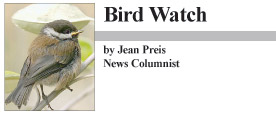Hummingbirds in late summer
 It is most pleasant to sit on the porch on a late summer afternoon, watching the birds come and go at the feeders. The air is warm, and humid. Voices drift over the water as vacationing families enjoy the final hours of the weekend. Children laugh, and call to one another. A motorboat goes by. A dog barks in the distance.
It is most pleasant to sit on the porch on a late summer afternoon, watching the birds come and go at the feeders. The air is warm, and humid. Voices drift over the water as vacationing families enjoy the final hours of the weekend. Children laugh, and call to one another. A motorboat goes by. A dog barks in the distance.
Our porch is the old-fashioned kind that wraps around three sides of the house. In summer it is a lovely place to relax, surrounded by bright pink geraniums that spill out of pots onto the floor and drape from hanging planters. The hummingbird feeder, suspended between a large asparagus fern and a hanging geranium, is a busy place, the scene of fierce territorial conflicts. One hummingbird often perches on a bare thin twig of the maple tree just a few feet from the feeder, where it can keep an eye on any other hummingbird that dares to approach. If another hummingbird does attempt it, the bird on the twig darts out and chases it away. These scrappy little creatures are only three-and-a-half inches long from the tip of the bill to the tip of the tail, and weigh a mere three grams, a tenth the weight of a first class letter, but they are fiercely aggressive and spend considerable energy defending the area around feeders.
The ruby-throated is the only species of hummingbird that breeds in eastern North America. Male and female adults are iridescent green above, and whitish below. The male’s deeply forked tail is green toward the center, and black on the sides, while the female’s tail is rounded, with white on the corners. Most folks can recognize the male’s brilliant scarlet throat if they see it in bright sunlight, but may not realize his throat looks black in the shade. Immature hummingbirds look like adult females, except they have faint vertical streaks on the throat.
After chasing the interloper away from the feeder, the defending hummingbird drops down from the maple twig to the feeder, lands on the red plastic perch, and thrusts its long bill into the feeding port. We have tried several types of feeders, but our neighborhood hummers seem to prefer the one with perches, even though they are quite capable of hovering on the wing when they are eating. They may look delicate, but hovering takes muscle, and hummingbirds can beat their wings up to eighty times per second, powered by breast muscles that can total thirty percent of the bird’s body weight. According to The Birder’s Handbook, they are capable of flying forward and backward, and can even fly upside down by spreading the tail and doing a backward somersault. To hover, a hummingbird moves its wings in a figure-eight pattern, with the “eight†lying on its side. An extremely flexible shoulder joint allows the wing to twist so the front edge leads, and generates lift, on both strokes. On the forward stroke the wing is right side up, and on the backstroke it is upside down. On the forward stroke, the wing travels very efficiently at increased airspeed through moving air caused by the backstroke. Inertia keeps the bird in one place because the directional thrust of each stroke is canceled out by the opposite stroke. What sounds complicated to us just comes naturally to these amazing little birds.
Hummingbirds stay around here well into September before heading south. It is not true that keeping feeders available will delay migration, since migration is influenced by the decreasing hours of daylight. A late migrating hummingbird would probably welcome a filled feeder along its route.
Summer may be winding down, but early autumn brings other pleasures. There will be crisp days, fall flowers, and migrating hawks to watch from mountaintops. I look forward to all of it, as well as to more quiet moments on the porch, watching any birds that may come to our yard.
Jean Preis is a resident of Bridgton

